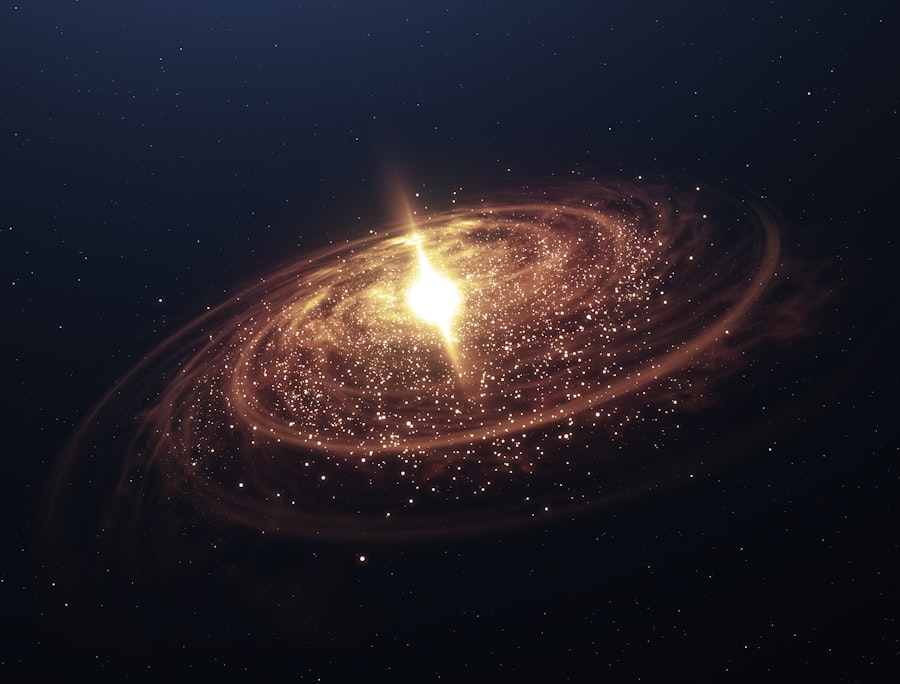Planetary nebulae are fascinating astronomical phenomena that represent a critical stage in the life cycle of certain stars. Contrary to what their name might suggest, they have nothing to do with planets. The term originated in the 18th century when astronomers observed these objects through telescopes and noted their round, planet-like appearance.
A planetary nebula forms when a medium-sized star, like our Sun, exhausts its nuclear fuel and undergoes a series of transformations that lead to the ejection of its outer layers into space. This process creates a glowing shell of ionized gas that can be observed across vast distances. The core of the star, now exposed after the outer layers have been shed, becomes a white dwarf.
This remnant is incredibly dense and hot, emitting ultraviolet radiation that ionizes the surrounding gas, causing it to emit light in various colors. The intricate structures and shapes of planetary nebulae can vary widely, ranging from spherical to more complex forms, often influenced by factors such as the star’s rotation and the presence of companion stars. The study of these nebulae not only provides insights into stellar evolution but also contributes to our understanding of the chemical enrichment of the interstellar medium.
Key Takeaways
- Planetary nebulae are glowing shells of gas and dust ejected by dying stars, often resembling planets in early telescopic observations.
- Planetary nebulae form when a dying star sheds its outer layers, creating a dense, hot core known as a white dwarf at its center.
- The stunning colors of planetary nebulae are produced by different elements in the gas and dust, with oxygen typically creating blue hues and hydrogen creating red and green hues.
- Scientists study planetary nebulae using telescopes and spectroscopy to analyze their composition, structure, and evolution.
- Planetary nebulae play a crucial role in enriching the universe with heavy elements and recycling material for future star formation.
The Formation of Planetary Nebulae
The formation of planetary nebulae is a multi-step process that begins with the life cycle of a star. Stars like our Sun spend the majority of their lives in a stable phase known as the main sequence, where they fuse hydrogen into helium in their cores. As the hydrogen supply dwindles, the star enters the red giant phase, during which it expands significantly.
In this phase, helium fusion begins, producing heavier elements such as carbon and oxygen. Eventually, the star can no longer sustain nuclear fusion in its core, leading to a dramatic transformation. As the core contracts under gravity, it heats up, while the outer layers are expelled into space due to strong stellar winds.
This ejection creates a shell of gas that expands outward at high velocities. The process is often accompanied by pulsations and instabilities that contribute to the nebula’s structure.
This material eventually enriches the interstellar medium, contributing to the formation of new stars and planets. The entire process can take thousands to tens of thousands of years, resulting in a beautiful nebula that can last for several tens of thousands of years before dissipating completely.
The Stunning Colors of Planetary Nebulae

One of the most captivating aspects of planetary nebulae is their vibrant colors, which arise from the ionization of gases within them. When the hot core of a dying star emits ultraviolet radiation, it interacts with the surrounding gas, causing electrons to become excited and subsequently release energy in the form of light as they return to their ground state. Different elements emit light at specific wavelengths, resulting in a spectrum of colors that can be observed through telescopes.
For instance, hydrogen emits a characteristic red color, while doubly ionized oxygen produces a striking blue-green hue.
The combination of these emissions creates a stunning visual display that can vary significantly from one nebula to another.
Some nebulae exhibit intricate patterns and gradients of color due to variations in density and temperature within the gas cloud. Observations using advanced instruments like the Hubble Space Telescope have revealed these colors in breathtaking detail, allowing astronomers to study the physical conditions within these nebulae and gain insights into their composition and structure.
How Scientists Study Planetary Nebulae
| Method | Description |
|---|---|
| Observational Studies | Using telescopes to observe planetary nebulae in different wavelengths such as visible light, infrared, and radio waves. |
| Spectroscopy | Analyzing the light emitted by planetary nebulae to determine their chemical composition and physical properties. |
| Computer Modeling | Creating simulations to understand the formation and evolution of planetary nebulae based on known physical laws and observations. |
| Space Missions | Sending spacecraft to study planetary nebulae up close and collect data on their structure and composition. |
The study of planetary nebulae involves a combination of observational techniques and theoretical modeling. Astronomers utilize various wavelengths of light—ranging from radio waves to X-rays—to gather comprehensive data about these celestial objects. Ground-based telescopes equipped with advanced imaging technology can capture detailed images of planetary nebulae, while space-based observatories like Hubble provide unparalleled views free from atmospheric interference.
Spectroscopy plays a crucial role in understanding planetary nebulae. By analyzing the light emitted from these objects, scientists can determine their chemical composition, temperature, density, and motion. This information helps researchers construct models of stellar evolution and understand how these nebulae contribute to the chemical enrichment of galaxies.
Additionally, computer simulations allow scientists to explore different scenarios regarding the formation and evolution of planetary nebulae, providing insights into their complex dynamics.
The Role of Planetary Nebulae in the Universe
Planetary nebulae play a significant role in the cosmic ecosystem by contributing to the recycling of materials in the universe. As stars evolve and shed their outer layers, they enrich the interstellar medium with heavy elements produced during their lifetimes. This process is essential for the formation of new stars and planetary systems, as these elements serve as building blocks for future generations of celestial bodies.
Moreover, planetary nebulae serve as laboratories for studying fundamental astrophysical processes. They provide insights into stellar evolution, nucleosynthesis—the process by which new atomic nuclei are created—and the dynamics of gas clouds in space. By examining these nebulae, scientists can better understand how stars influence their environments and how galaxies evolve over time.
The study of planetary nebulae thus contributes to our broader understanding of cosmic history and the interconnectedness of various astronomical phenomena.
Famous Planetary Nebulae

Several planetary nebulae have gained notoriety among astronomers and enthusiasts alike due to their unique characteristics and stunning appearances. One such example is the Ring Nebula (M57), located in the constellation Lyra. This iconic nebula is known for its distinct ring shape and vibrant colors, making it a favorite target for amateur astronomers.
The central star within M57 is a white dwarf that emits intense ultraviolet radiation, ionizing the surrounding gas and creating its characteristic glow. Another notable example is the Helix Nebula (NGC 7293), often referred to as the “Eye of God” due to its resemblance to an eye when viewed from Earth. Located approximately 650 light-years away in the constellation Aquarius, this nebula is one of the closest to our planet and has been extensively studied for its intricate structure and rich chemical composition.
Its bright blue-green color results from emissions from doubly ionized oxygen and hydrogen. The Cat’s Eye Nebula (NGC 6543) is another striking example that showcases complex structures and vibrant colors. Located about 3,300 light-years away in the constellation Draco, it features intricate filaments and knots that hint at its dynamic history.
The Cat’s Eye Nebula is particularly interesting because it exhibits multiple shells and lobes, suggesting that it has undergone several episodes of mass loss during its evolution.
The Future of Planetary Nebulae Research
As technology advances, so too does our ability to study planetary nebulae with greater precision and detail. Upcoming space missions and ground-based observatories are expected to enhance our understanding of these celestial objects significantly. For instance, telescopes equipped with adaptive optics will allow astronomers to observe finer details in planetary nebulae by compensating for atmospheric distortions.
Additionally, future missions like NASA’s James Webb Space Telescope (JWST) will provide unprecedented infrared observations that can penetrate dust clouds surrounding some nebulae, revealing hidden structures and components that were previously obscured. This capability will enable scientists to explore not only individual planetary nebulae but also their interactions with surrounding environments. Moreover, ongoing research into stellar populations within galaxies will shed light on how planetary nebulae contribute to galactic evolution over cosmic time scales.
By studying large samples of these objects across different environments—such as star-forming regions versus older stellar populations—astronomers hope to uncover patterns that reveal how stellar death influences galactic dynamics.
Appreciating the Beauty of Planetary Nebulae
Beyond their scientific significance, planetary nebulae captivate observers with their breathtaking beauty. The vibrant colors and intricate structures evoke a sense of wonder about the universe’s complexity and artistry. Many amateur astronomers find joy in observing these celestial wonders through telescopes or even binoculars on clear nights.
Artistic representations inspired by planetary nebulae have also emerged in various forms—ranging from paintings to digital art—capturing their ethereal qualities and inviting viewers to contemplate their place in the cosmos. Public outreach programs often include stunning images captured by professional astronomers to inspire curiosity about astronomy among people of all ages. In essence, planetary nebulae serve as both scientific subjects and sources of inspiration for humanity’s quest for knowledge about the universe.
Their beauty reminds us that even in death, stars contribute to a cycle that fosters new life and enriches our understanding of existence itself. As we continue to explore these celestial phenomena through research and observation, we deepen our appreciation for both their aesthetic allure and their role in shaping the cosmos around us.
If you are interested in learning more about the scientific study of the universe, you may want to check out an article on markup languages. Markup languages play a crucial role in organizing and presenting information, much like how planetary nebulae are essential in understanding the life cycle of stars. Both topics involve the systematic organization of data to enhance our understanding of complex systems.





















+ There are no comments
Add yours